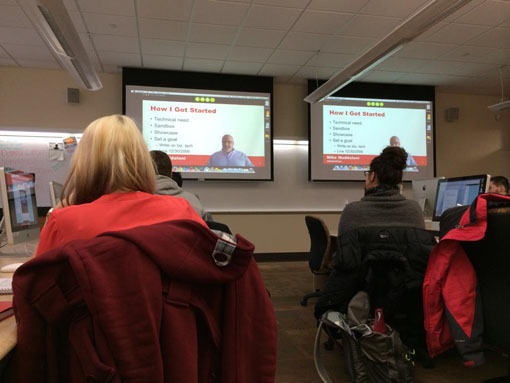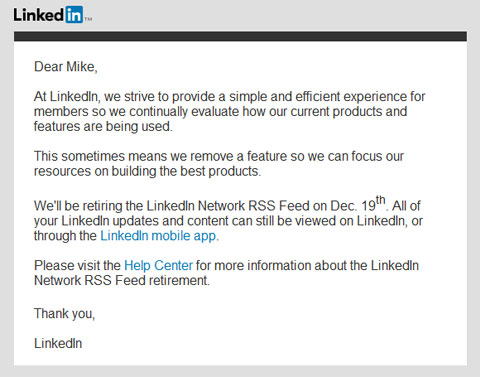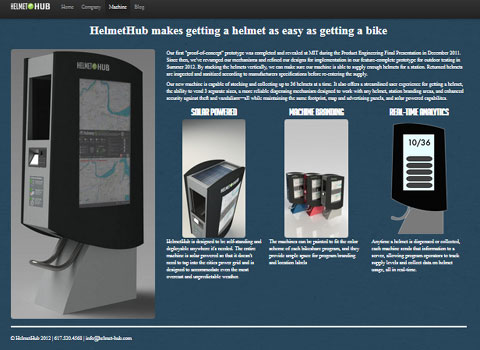My Blogging Guest Lecture At University of Wisconsin-Oshkosh #uwonewmedia

Photo credit: Wilke (?@Wilke_411) via Twitter
Yesterday I had a distinct honor to guest lecture to college students on the topic of blogging.
I was invited to speak to 2 classes at the University of Wisconsin-Oshkosh by journalism professor Dr. Sara Steffes Hansen. As part of her classes where she is teaching the students all aspects of blogging, each student is building a real, public blog. What better way to learn blogging than with real-life experience?
As someone who has his own blogs and has built blogs for clients, I have learned on the job about blogging as well as keeping up with trends and changes to blogging over the years. One challenge was focusing on key elements to share with the students and keep it to a brief presentation with time for their questions. Another challenge was that I would not be able to be physically in the lecture hall on the Oshkosh campus, yet deliver my messaging in an interesting and engaging way.
As with my own writing style, I decided to tell the story of how I got into blogging myself and then focus on areas that I felt were important to the students, including the art and science of writing and writing on a regular basis, plus some key pointers about blogging such a sharing and social media integration.
For the presentation itself, I created PowerPoint slides and used technology from Personify to literally insert myself into the PowerPoint presentation so that when the students were looking at the screen they saw both the slide material as well as myself, as you can see from the picture above. As the Personify technology is extremely unique in itself, I'm already writing another post on using Personify and how I was successful in conveying myself, my style and my message to the students remotely – watch for it soon.
I have posted the slides from the presentation to SlideShare and you can link to it here or view embedded below. I kept the slides at a high-level and spoke to the details so that the students did not have to read slides, and by using the unique Personify technology I was able to make that happen very well. If you look at the slides and are wondering about the references to Ernest and Edgar, those are to 2 “other” famous Chicago-area writers, Ernest Hemingway and Edgar Rice Burroughs, as I used them as examples of different approaches to writing.
Thanks again to Dr. Hansen, the team at Personify and the students who asked great questions and shared the presentation on social media. It was great getting back into the classroom and I am looking forward to my next opportunity.
This is from The Hot Iron, a journal on business and technology by Mike Maddaloni.
Did you enjoy this? Subscribe to The Hot Iron by RSS/XML feed or Read by Email.
Announcements • Blogging • Build • Social Media • Strategize • Technology • Thrive • Web Design • (0) Comments • Permalink
My Worst Managers Never Took Me To Lunch

When I look back across my career at the variety of managers I have had, there is a broad spectrum of them from amazing to horrible and everything in between. As I was recently thinking of those I considered the “worst” – those whom I had a poor experience working with – a common denominator came to light that I feel is central to why things did not work out well.
They never took me to lunch.
More Than A Meal
Don’t get me wrong, I am not just looking for a free meal, nor do I think these people are cheap in any way. Frugality with a corporate spending account has come up in dealings with past managers, and for me it is near the bottom of the list.
The fact these managers did not take me to lunch goes well beyond the meal itself and its cost. It has to do with the overall action itself – getting out of the office, a 1-on-1 meeting in a different setting and the discovery and insight about each other that comes with the conversation over the meal. Or in short – the manager getting to know me better, and me getting to know the manager better. This deeper knowledge about a person is important for a working relationship, going beyond the surface and skillsets to truly get the most of that person, and ensure they are happy and satisfied in the work environment.
Meals Alone Don’t Make A Manager
Where I feel that the invitation and act of taking someone to lunch is important in a working relationship, it is not the defining moment for a manager if they do so. In all honesty, most all of the managers I have had in all my years have broken bread with me, some at least once and others on a regular basis. And those managers would be represented across the above-mentioned spectrum. Even those whom I would rank along the lower end of that spectrum, I feel by having had a meal with them, and getting to know them as more than what was written on their business card, outranks those few who did not take this time or see it as important.
My Own Experience With Meal Invites
Where I have been talking about being on the receiving end of a meal invite from a manager, in my own role as a manager over the years I have taken many people to breakfast, lunch, dinner, coffee, snack or food in some capacity outside of the office and away from the grind to have a conversation. Call it the Italian-American in me, or just call it effective, but this opportunity to further connect with a team member or colleague is a very important part of how I have been successful throughout my career.
Here’s a couple of ways I have integrated lunch and my teams.
Re-energizing After Being Dazed And Confused
It was one of those meeting where you sit there and wonder, with all of this brain power, could we possibly cure cancer? But alas in the end really nothing was accomplished other than puzzled looks on everyone's faces and bad tastes in everyone's mouths.
I was asked to come to an "emergency" meeting and to bring my developers and even my graphic designer. As the manager of the front-end design and development team part of my job was to be the conduit between my team and senior leadership, who called the meeting and the people who did the great things to make our application a reality. In short, I would shield them from the insanity of such meetings. However the requesters pulled rank - literally - and demanded all of us in the meeting.
To make a long story - and long meeting - short, we all didn't need all of the king’s horses and all of the kings subjects to be in the meeting, and after an hour or so we all staggered out of the meeting room with the above mentioned looks and tastes.
Once we all collected in the lobby I decided the team needed to be rewarded for enduring this, so I told them that I would be taking them to lunch. The meal would be on the company, but only if we did not talk about work; if anyone brought up work they would have to pay for their own meal. Needless to say everyone agreed. As we walked back from the restaurant, I realize that we had bonded even deeper as a team than we had before and learned a lot about each other's backgrounds and beliefs, and I feel it had a great impact on our teamwork going forward.
Not When But When I Want To
After joining a start-up company and signing my life away (and possibly my future first born) I was then given our business plan our operating guides, policies and procedures. Reading through all of it I noticed there was no mention about specific business expenses, namely meals. I raised this with our HR director who told me to talk with our CFO, and my conversation with him went something like this:
Me: “Hi Homer (not his real name), what is the policy on expensing meals?”
CFO: “Um, who are you taking to lunch?”
Me: “Members of my team, and others in the company?”
CFO: “Um, when?”
Me: “Whenever I want to!”
CFO: “Um…”
At that point I talked with the company president, whom I had interviewed and talked with extensively during the onboarding process to the company, and he knew my leadership philosophy and told me to take whomever, whenever, and to expense it. These meals, sometimes, at the local mall food court, sometimes at a sit-down restaurant, were integral to me getting to know the team I inherited at the start-up, who they were, what motivated them, and importantly issues they had within the company. Although I was only with the start-up for 6 months and 5 days (a story for another time!), it was a productive time and I got some great things out of our team.
More Than A Skillset
If you read other posts here at The Hot Iron you will see I talk quite a bit about managing and leading people, and it involves a deeper knowledge of who they are, in addition to what they do. Frankly, it just works for me – always has, and I believe it will in the future. Some have labeled my approach as “touchy-feely” and so be it – we all have our styles, and in the end it’s up to the person as to whom they want to work for. Needless to say, I am not looking to work again with those past managers who didn’t take me to lunch.
I welcome your thoughts and comments on my approach in the comments to this post. Has meetings over meals worked for you or not? Do you see it as a way to deepen a working relationship, or just fill your belly?
This is from The Hot Iron, a journal on business and technology by Mike Maddaloni.
Did you enjoy this? Subscribe to The Hot Iron by RSS/XML feed or Read by Email.
Build • Business • Strategize • Web Development • (1) Comments • Permalink
The Work Project I Never Politically Worked On
Ah, company politics. They can be anything from mildly amusing to wrenchingly painful. In any case, they are at a minimum something you shake your head at. Unfortunately there are politics of some form in every work place and it really depends on the people involved as to how bad the politics can be.
The following story is one of company politics that to this day I still shake my head and laugh at. However at the time I admit I was pretty pissed off about it. It is a true story – one that I went through myself about a dozen years ago. The names of people in the company of all been changed to protect the innocent or feeble.
I was working in internal IT for a software company supporting the software and hardware for its public Web site and Intranet. Along came a major project where the company was going to implement PeopleSoft, an enterprise resource management or ERM system. As a result, everyone in IT was supposed to be working on the PeopleSoft project and not on anything else, including the work I was doing on our Web site and Intranet. Of course reality is always something different, as there was nobody else to technically support either of those projects, and I continued to support both.
One day I got a call about a major project the company was undertaking. It was going to go through a significant rebranding effort, keeping the same logo but rebranding all products and services including a new Web site. Although we had plenty of technical people in the company, I was the person to work on the new Web site as I knew it best, from the marketing team to the infrastructure to code behind it. The call had come from the marketing manager whom I had worked with since I've been there supporting the Web site. I then told her what the new “situation” was in IT, where I was not supposed to be supporting the current Web site, let alone build a new one. Needless to say this didn't make any sense to her, but she understood well how the company politics was, especially in IT.
Next up for her was to raise the “situation” up through her management, which then brought it up to the IT management and then came back down to me. I got a call from my manager who told me that after all I was supposed to work on the new Web site. But there was only one stipulation: I wasn't politically supposed to be working on this project therefore I wasn't supposed to tell anyone about it. So technically I was wasn’t working on the project, even though it was going to take most all of my time for the next several months.
Makes perfect sense right? I didn't think so.
Despite the insanity of the “situation” I had a job to do. A lot of work went into building the Web site, but it was something enjoyed doing very much and it didn't seem like a job at all. I was working very closely with our marketing manager, where I was located in Boston and she was in Vermont. Throughout the entire project we never actually saw each other, but despite that we were extremely successful at what we built.
In addition to building the Web site, I was also responsible for registering and acquiring new domain names for our rebranded products and services. As this was a publicly traded company, the rebranding was very secretive and very few people knew what the new product names were to be. But I was one of them. So that's a lot of faith and confidence in the guy that's not officially working on the project.
Overall the project was a success and we launched the new Web site on the day the company launched the rebranding. A lot of hard work and long hours went into it, and where we were very relieved when it was over, there was a lot of pride in the work we did. About a week after the rebranding, an email came out from the president of the company thanking individually all the people who worked on the rebranding. That is, all except for me. Of course this made complete sense because the president wasn't told I worked on the project because for political reasons I wasn't working on the project as nobody from IT was supposed to be working on anything else but the PeopleSoft project.
No sooner did the email come out from the president, I got a call from the marketing manager who was completely shocked that I was left off the list. I have to admit I was slightly irate I didn't get official recognition, but I knew the “situation” and took it for what it was. At least my immediate colleagues knew I worked on the project and I got kudos from them. Where I did not get credit from the president, I knew what I did and was just as proud as I was before the email came out.
Several weeks later we had an all-hands meeting for the IT organization. As I wasn't really in the mood for going to listen to this meeting in person, I decided just to dial into it from my desk. At the conclusion of the meeting the chief information officer, or CIO, brought up the rebranding project and even singled me out for the work that I did on it. What? Public recognition from the guy who had decided I technically didn't work on the project and made sure that I didn't get credit for it from the president of the company? Needless to say I was mildly irate and may have even made a gesture at the phone as I was listening to this. Interestingly, the CIO himself never personally thanked me for the work that I did on the Web site, and knowing how he operated even his public acknowledgment was very halfhearted.
It's one thing going into a consulting project or a contract knowing that for proprietary reasons you can't reference you worked on a project. When it comes to political reasons for not working on a project, they typically make absolutely no sense and are more to cover for someone than anything else. This was the case here, in a company with plenty of resources and a “leader” who would not acknowledge a significant company effort in order to keep to his marching orders that all-hands would be working on the ERM initiative. Of course by that statement alone there is no leadership shown.
Have you ever been in a similar situation? How would you have reacted if it was you? I welcome your thoughts in the comments to this post.
This is from The Hot Iron, a journal on business and technology by Mike Maddaloni.
Did you enjoy this? Subscribe to The Hot Iron by RSS/XML feed or Read by Email.
Build • Business • Technology • Thrive • Web Development • (0) Comments • Permalink
LinkedIn Shutting Down Network RSS Feed On December 19, 2013 To My Dismay
For as many great major and incremental changes LinkedIn has made the business social networking service, they have eliminated a few services which I found resource rich and grew dependent on. One was LinkedIn Answers, a robust business question and answer section of the service which was shut down and disappeared earlier this year. Add to the list the RSS feed of network updates, which a few days ago I was informed it is going away as of the end of this week on December 19.
The following is an image of the email message I received from LinkedIn.

The following is the text of the email message I received from LinkedIn.
Dear Mike,
At LinkedIn, we strive to provide a simple and efficient experience for members so we continually evaluate how our current products and features are being used.
This sometimes means we remove a feature so we can focus our resources on building the best products.
We'll be retiring the LinkedIn Network RSS Feed on Dec. 19th. All of your LinkedIn updates and content can still be viewed on LinkedIn, or through the LinkedIn mobile app.
Please visit the Help Center for more information about the LinkedIn Network RSS Feed retirement.
Thank you,
For some time now I have been subscribed to the RSS feed of my network updates. If you use LinkedIn, this is the information on its home page, which shows updates to your connection’s profiles as well as articles they have shared, groups they have joined, if they have a new connection, etc. This would allow me to see each and every update in my growing network, which was valuable to see where people were moving and information they were sharing. It was also much easier to read, as I could scan the headlines of these changes and posts, and click on anything I wanted more information on.
In other words, the network RSS feed was simple and efficient. But wait, isn’t that the same reason why LinkedIn gave for killing it?
If you couldn’t guess I love RSS!
It goes without saying that I love RSS as it is the primary way I keep informed. RSS is not just for blogs, as I get it for news, weather, sports, events, and networking information. Of course the networking information will decrease as a result of LinkedIn eliminating the network RSS feed.
Using my RSS reader of choice, Fever, I am able to aggregate all of the above information and then some. In the case of LinkedIn, I feel because of the RSS feed I am visiting their site more often, and in the process viewing the banner ads they are selling, not to mention good old-fashioned networking. Did I mention I am viewing the banner ads more often as a result of RSS?
Business decisions for business networking
My guess is I am one of a small minority of people who actually subscribe to the RSS feed, and as a result they are simply turning off the functionality. LinkedIn promoted the RSS feed, complete with the orange RSS icon, at the top of the network updates list. I can’t remember the last time I have seen this. As I have seen little uproar from others about the cancelling of this service, maybe that minority is, as I’d say in Boston, wicked small?
In addition, by controlling the display of network updates, they have the ability to offer more information and services, such as sponsored updates. I have noticed these on the site but not in my RSS feed. Of course to add these to the feed would cost money and resources, and from their message, this is something the new-publicly traded business does not want to do.
RSS is still not dead, #VIVARSS
In the end, after the dust settles from the nuclear winters, it will be just the cockroaches and RSS. Why? Well, as for RSS, it is open and distributed, does not rely on a continuous network connection to work, and is very simple to read and process. After Google killed its Reader RSS aggregator, many wondered if RSS was dead technology. Where it may not be the shiny new object on the Internet that it was, it is a core service that can easily be adopted and utilized, and that in itself makes it valuable.
Did the LinkedIn Network RSS feed shutdown impact you? Did you even know it existed? Share your thoughts in the comments of this post.
This is from The Hot Iron, a journal on business and technology by Mike Maddaloni.
Did you enjoy this? Subscribe to The Hot Iron by RSS/XML feed or Read by Email.
Build • Business • Technology • Web Development • (5) Comments • Permalink
Follow-up On Divvy Bikes And Helmets – Boston Debuts Helmet Vending Machine
About a month ago I wrote here on The Hot Iron about how Divvy, the extremely popular bike sharing program in Chicago, did not offer helmets. I also discussed several options for them to offer helmets to their riding customers, including people selling them to the idea of a helmet vending machine.
Little did I know such a helmet vending machine had been developed, and last week was introduced in Boston for its bike sharing program. HelmetHub is a vending machine which was born out of MIT, and offers to either sell or rent a helmet. The vending machines have a style similar to the bike rental stations in Boston and Chicago (which are run by the same company) and will fit in well with those stations.
You can read more about HelmetHub on their Web site and see pictures and options for the vending machines.
It’s great to see such a service offered, and nice to know I was not the only one thinking along this line.
Would you buy a helmet from a vending machine? I welcome your thoughts in the comments of this post.
This is from The Hot Iron, a journal on business and technology by Mike Maddaloni.
Did you enjoy this? Subscribe to The Hot Iron by RSS/XML feed or Read by Email.
Build • Business • Strategize • Technology • (2) Comments • Permalink




